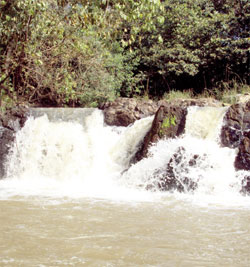Ferdinand Mwongela was at Kakamega Forest, the only remnant in Kenya of the unique Guineo-Congolian forest ecosystem, where he came across tree species with both healing and killing tendencies
This rainforest is old and impressive — some of the trees are easily over a hundred years old. I had been told that the best time to visit the forest is during the rainy season (April-July) when the flowers are blooming, but here I was in the blazing sun heading to Western Kenya.
My encounters with any forests had so far been limited to Science classes, but when I heard that Kakamega Forest is home to about 350 species of birds, including snake-eating birds, which are rare, I knew I had to experience it.
A Swedish couple who had visited the area were left in awe. "Peaceful and beautiful and, as an extra bonus, close to the rainforest. Here and there, clay huts, scattered between tiny fields. A stream at the bottom of the valley and a small area with remaining rainforest on the opposite ridge," they wrote in a book entitled Blue-Eyed in Luhya Land.
When I got here, however, it was well into the evening and the beauty of the land was lost in the chilly embraces of the high canopy trees. I must say driving from Kisumu to Kakamega is a torture given the state of the road and I felt sorry for our vehicle. Luckily, we were here in peace and in need of rest.
While outside the forest, the January wind and dust threatened to drive everyone blind, in the forest, a slight drizzle had left the place damp and for a moment I had doubts about spending the night here. I could imagine the cold at night and was not willing to partake of it.
We checked into a self-catering Kenya Wildlife Service run Isukuti Guest House where a hot bath dispelled every cold fear. We were up early the next morning to catch the sunrise above the tree-tops as was everyone else.
Our guide, I am sure with a twinkle in his eyes, had mentioned the previous night that the forest had at least 27 species of snakes. Once we ditched the cruiser on our way to Buyangu Hill viewpoint, I was careful not to be the last person on the tail remembering the guide’s words. Exhortations by the guide that snakes don’t attack unless provoked was not comforting either.
White sheet
A note on the platform at the Buyangu Hill viewpoint claimed that from here one could see 240 square kilometres of the forest. But in the early morning all I could see was the mist covering the top of the forest like a cotton white sheet and a few of the more daringly tall tress peeping shyly from the sheet cover.
 |
The enchanting Isiukhu River falls |
After waiting around for about 30 minutes, we were rewarded with the sun rising slowly from the east. At first only a red sky then the first few rays of the sun following behind slowly like a shy child behind its mother’s skirt.
Curiosity satisfied and with the sun high in the sky, we went off in search of breakfast. Later we embarked on a nature walk down Mukangu trail, which I learnt was 850 metres long. For fear of reptiles, I once again stuck to the middle of the single file.
Following the trail felt uncannily like walking into a tunnel, a very green and damp tunnel. The trees stand in some places at a height of about 45 metres. Our guide came to a stand between a Prunus Africana, which he pointed out, can cure prostrate cancer. Very unassuming, unlike its friend the strangler Fig, it is a tree you would pass by without noticing.
A few metres on, the Lianas stood looking like giant snakes coiled around a prey. The Liana, a long stemmed vine, uses its neighbours in the forest kingdom to climb as high as possible. It reminds one of the animal kingdom where survival is key.
The strangler fig is a deadly predator here. From a far it seems like a huge tree but on closer inspection it’s revealed that the strangler fig is only on the outside while its prey is enclosed in this deathly embrace. The tree ‘strangles’ life from the prey then takes its place slowly merging the dead tee into itself. By the time it is done, you cannot even tell there had been another tree.
Diverse plants
After some morbid fascination with the intimacies of survival in the forest, the next stop was beside a tree going by the local name of Mwanz. This tree’s trunk is useful in the making of isikuti drum famous in this region and beehives. For this very reason, it is one of the endangered tree species here, caught between the triangle of man’s desire for entertainment and food and its own survival. Several other tree species are endangered here including the Elgon Teak.
Then came the biblical lesson in the form of the Sycamore tree. Our guide smugly pointed out that when Adam and Eve were ‘busted’ after eating the forbidden fruit, they covered themselves with the leaves of the sycamore tree.
While the plant life here is so diverse, few stand out. Among the prominent residents of the Kakamega Forest is the Ficas Natalensis. Its fruit grow even on its trunk, hidden in crevices and is an important nesting place for snakes and birds.
At another point, three trees grew close together to resemble a three-in-one tree. Unfortunately for them, one is the strangler fig and it is only a matter of time before it kills its friends.
Inundated with the knowledge of trees, their healing properties and killer tendencies, we decided to pay a quick visit to the Kisere Nature Reserve on the other end of the forest. The reserve is sandwiched between the Isikhu and Nandamanywa rivers.
 The Standard Group Plc is a multi-media organization with investments in media
platforms spanning newspaper print operations, television, radio broadcasting,
digital and online services. The Standard Group is recognized as a leading
multi-media house in Kenya with a key influence in matters of national and
international interest.
The Standard Group Plc is a multi-media organization with investments in media
platforms spanning newspaper print operations, television, radio broadcasting,
digital and online services. The Standard Group is recognized as a leading
multi-media house in Kenya with a key influence in matters of national and
international interest.
 The Standard Group Plc is a multi-media organization with investments in media
platforms spanning newspaper print operations, television, radio broadcasting,
digital and online services. The Standard Group is recognized as a leading
multi-media house in Kenya with a key influence in matters of national and
international interest.
The Standard Group Plc is a multi-media organization with investments in media
platforms spanning newspaper print operations, television, radio broadcasting,
digital and online services. The Standard Group is recognized as a leading
multi-media house in Kenya with a key influence in matters of national and
international interest.










